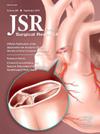Optimizing Efficacy of Vacuum Bell Therapy for Pectus Excavatum: Compliance is Key
IF 1.8
3区 医学
Q2 SURGERY
引用次数: 0
Abstract
Introduction
Pectus excavatum (PE) is the most common congenital chest wall deformity. The vacuum bell (VB) is a nonoperative alternative to surgical correction. We reviewed our center's experience with VB for PE to identify variables associated with improved therapeutic success, with a focus on compliance to prescribed VB therapy.
Methods
We conducted a single-center retrospective review of patients with PE who initiated VB therapy from August 2020 to August 2023. Patients who were fully compliant with therapy (defined as 28 h/week) were compared to patients who were noncompliant (<27 h/week). Multivariable linear regression was used to identify factors predictive of pectus excavatum depth (PED) correction.
Results
Fifty-seven patients (86% male) initiated VB therapy. Of these, 22 patients (38.6%) were compliant with prescribed VB usage and 35 (61.4%) were noncompliant. There was a significant difference in PED correction between compliant and noncompliant groups (28.0% versus 16.0%, P < 0.001). Hours of VB usage per week was the strongest predictor of PED correction (P = 0.023). Days of treatment and lower initial Haller index also significantly predicted PED correction (P = 0.036 and P = 0.043, respectively), while height, weight, age, sex, and initial PED were not significant predictors.
Conclusions
Although age and initial PED are thought to affect VB efficacy, our data demonstrates that when compliance with therapy is factored, these variables do not significantly predict therapeutic success. Therefore, for a highly compliant patient, VB therapy can be effective regardless of age or severity.
求助全文
约1分钟内获得全文
求助全文
来源期刊
CiteScore
3.90
自引率
4.50%
发文量
627
审稿时长
138 days
期刊介绍:
The Journal of Surgical Research: Clinical and Laboratory Investigation publishes original articles concerned with clinical and laboratory investigations relevant to surgical practice and teaching. The journal emphasizes reports of clinical investigations or fundamental research bearing directly on surgical management that will be of general interest to a broad range of surgeons and surgical researchers. The articles presented need not have been the products of surgeons or of surgical laboratories.
The Journal of Surgical Research also features review articles and special articles relating to educational, research, or social issues of interest to the academic surgical community.

 求助内容:
求助内容: 应助结果提醒方式:
应助结果提醒方式:


